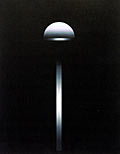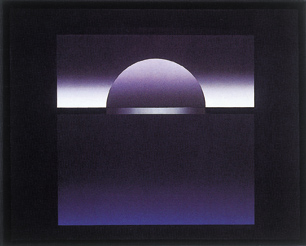
Adnan Çoker studied at Zeki Kocamemi workshop in
İstanbul State of Fine Arts Academy between 1944-1951 and learned
composition details from Halil Dikmen. He graduated from the Painting
Department of the Academy. Winning the European Competition, he went
to Paris through a state scholarship. He established the Blue Group
with his four friends in 1963. With a state grant from France, he
studied painting at Goetz workshop and engraving at the Hayter
workshop during 1964-1965. He worked as a faculty member at State Fine
Arts Academy in İstanbul and Mimar Sinan University. He showed over
thirty solo exhibitions and joined numerous exhibitions and biennials.
He received eight prizes, including the Friendship and Peace Art Award
of the 3rd International Asia-European Arts Biennial in
1990. Çoker continues his work in İstanbul.

İstanbul Devlet Güzel Sanatlar Akademisi Zeki Kocamemi
Atölyesinde 1944-1951 yılları arasında çalışan Çoker, Halil Dikmenden
kompozisyon bilgileri edindi. Akademinin Yüksek Resim Bölümünü
bitirdi. 1955te Avrupa konkurunu kazanarak devlet bursu ile Parise
gitti. 1963te dört arkadaşı ile Mavi Grupu kurdu. 1964-65 yılları
arasında Fransız bursu ile Pariste Hayter Atölyesinde gravür, Goetz
Atölyesinde resim çalıştı. İstanbul Devlet Güzel Sanatlar Akademisinde
ve Mimar Sinan Üniversitesinde öğretim üyesi olarak çalıştı. Otuzun
üzerinde kişisel sergi düzenledi, yurtiçinde ve yurtdışında çok sayıda
karma sergiye ve bienallere katıldı. Yapıtları ile sekiz ödül aldı.
Sanatçıya verilen ödüller arasında 1990da III. Uluslararası
Asya-Avrupa Sanat Bienali Dostluk ve Barış Sanat Ödülü de
bulunmaktadır. Sanatçı çalışmalarını İstanbulda sürdürmektedir.
Material
Illusion
All the unique elements and values in Adnan Çoker's paintings are individually
an absolute whole, thereby distinguished from the absolute, and truly united in
one at the organic working level. The character of these paintings is a quality
transition from the historical starting point, and carries us into a sphere
nourished by the imagination of the artist. While the object of the imagination
is transformed into aesthetic representation on the canvas, this pictorial
representation in which the general is viewed through the particular is entirely
allegorical. The artist follows the course of a composition that is analytic
rather than synthetic. He uses his canvas among other things to fragment, to
revive historic symbols, and to create new space. Another characteristic of his
work is his depiction of the space outside the objects as space. The part of his
paintings which give the impression of being a black background is the space
created by the artist.

Adnan Çoker's aesthetic expression is the encounter of that deriving from the
essence with that deriving from the universal symbol of history, with the
present moment, by means of an enormous leap. What is in the essence of the
artist finds new form in the balance of form and colours which reduce the whole
of cognitive combinations to a minimum. In his large canvases the historical
starting points are Seljuk, Byzantine and Ottoman aesthetic concepts and images,
a supra-cognitive transformation brings us face-to-face with the renewed form-colour
concept and balance. The artist sees black not so much as a colour as space, a
sense of dimension, integral to his works. In the course of creating material
illusion on the canvas, with the help of pictorial elements, the artist moves
from the visual sphere to tangible space. Material reality and the artist's
space are fused together. Simplicity of form, reliance on the minimum, and
sparing use of colour characterise his work. Relationships between the elements
in his paintings serve to bind the whole.
From the thematic point of view, a large dome represents the city of Istanbul
which he loves so dearly, and beyond we encounter a composition in which
historic images are interpreted. The principal subjects of his work are, as can
be seen from their titles -Sky Dome, Double Monument, Tribute to Sinan, Oriental
Niches- and so on - traditional values and nature.
Madde
İllüzyonu
Adnan Çoker

Gülseli
İnal
Şair - Sanat Yazarı
Adnan Çoker'in
resmindeki bütün özel elemanlar ve değerler her biri kendi başına evren,
her biri mutlak bütün olma yoluyla mutlak olandan ayrılmış ve dirimli çalışma
düzeyinde gerçekten birdirler. Resimlerin ırası tarihsel çıkış noktasından
niteliksel bir geçiş olduğu kadar, sanatçının hayalgücünün beslemiş
olduğu bir alana da vardırır bizi. Hayalgücünün nesnesi tuvallerde estetik
betime dönerken içinde genel olanın özel yoluyla görüldüğü resmin
tasviri bütünüyle alegoriktir. Sentezci değil analizci bir kompozisyonun
izleklerini süren sanatçı parçalara ayırma, tarihsel imleri diriltme, yeni
bir espas yaratma gibi eylemlerle yükler tuvali. Adnan Çoker resminin bir diğer
özelliği de resimde nesnelerin dışındaki uzamı uzam olarak tasvir
etmesidir. Resimlerdeki siyah fon izlemini uyandıran bölüm sanatçının
kurguladığı espas ve oluşturduğu uzamdır.
Adnan Çoker estetik ifadesi, özden gelenle evrensel "im"in tarihten
gelenle şimdiki anın büyük bir sıçramayla buluşmasıdır. Sanatçının
özünde olan: Düşünsel kombinasyonları bütünü en aza indirgemiş ibçim
ve renkler dengesinde yeniden biçimlenirler. Tarihsel kalkış noktaları Selçuk,
Bizans, Osmanlı estetiği ve betimleri bünyesinde bir üst-zihinsel değişimle
büyük tuvallerde biz yenilenmiş bir biçim-renk anlayışının ve dengesinin
kendisiyle karşılaşırız. Siyah renk sanatçıya göre bir renk olmaktan
daha çok bir espastır, boyut duygusudur ve yapıtlarla bütünleşir. Sanatçı
tuvalde madde illüzyonunu gerçekleştirirken resimsel elemanların yardımıyla
görsel alandan dokunabilinir espasa geçmektedir. Madde gerçeği ile sanatçının
espası iç içe yer alırlar. Biçim sadeliği, "az"a başvurma ve
renk azlığı onun karakteridir. Resimlerde elemanlar arası ilişki resmin bütününe
hizmet vermektedir.
Tematik açından bakıldığında; resimlerinde bir büyük kubbe ile çok
sevdiği İstanbul kentini anlatırken, daha ötede tarihsel imajların
yorumlandığı bir kompozisyon bizi karşılar. Sanatçının ağırlıklı
konuları yapıtların isimlerinden de anlaşıldığı gibi Gök Kubbe, Çifte
Anıt, Sinan'a Saygı, Oryental Nişler gibi geleneksel değerlerden ve doğadan
yola çıkılarak yapılan bu çalışmalardır.

26 KASIM 1986
Prof. Devrim Erbil, Prof. Adnan Çoker,
Prof. Dinçer Erimez ve öğrencileri
|